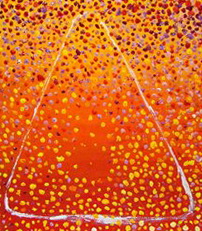The fourth-century Cappadocian Fathers tried to communicate this notion of life as mutual participation by calling the Trinitarian flow a “circle dance” (perichoresis) between the three. They were saying that whatever is going on in God is a flow that’s like a dance; and God is not just the dancer, God is the dance itself! The Incarnation is a movement—Jesus comes forth from the Father and the Holy Spirit to take us back with him into this eternal embrace, from which we first came (John 14:3). We are invited to join in the dance and have participatory knowledge of God through the Trinity.
Trinity is the very nature of God, and this God is a circle dance, a centrifugal force flowing outward, and then drawing all things into the dance centripetally. If this God names himself/herself in creation and in reality then there must be a “family resemblance” between everything else and the nature of the heart of God.
Scientists are discovering this reality as they look through microscopes and telescopes. They are finding that the energy is in the space between the particles of the atom and between the planets and the stars. They are discovering that reality is absolutely relational at all levels. When you really understand Trinity, however slightly, it’s like you live in a different universe. And a very good and inviting one!
Adapted from The Divine Dance: Exploring the Mystery of Trinity, disc 1
(CD, MP3 download);
and What Difference Does Trinity Make?
(MP3 download);
and The Shape of God: Deepening the Mystery of the Trinity, disc 1
(CD, DVD, MP3 download);
and Eager to Love: The Alternative Way of Francis of Assisi, p. 244
Gateway to Silence:
God for us, we call you Father.
God alongside us, we call you Jesus.
God within us, we call you Holy Spirit.
* * *
Note: Here is a clarification, mostly for theologians, and those interested in theology. As I have explained in my PhD thesis (which used perichoresis as a central concept):
‘One implication of the active sense suggested by circumincessio is the beautiful metaphor of the ‘divine dance’, first used in the Middle Ages as an image of divine perichoresis. The metaphor is in fact based on confusion or, at best, on a play on words. Thus the verb chorein, meaning ‘to contain’, is confused with the Greek word choreuo, meaning ‘to dance’, from which is derived perichoreuo, meaning ‘to dance around’. Thus Hamilton talks about ‘perichoresis, with its etymological connection with dance’.
Nevertheless, in spite of the fact that the metaphor of the ‘divine dance’ is based on a faulty etymology, we agree with Fiddes that ‘the play on words illustrates well the dynamic sense of perichoresis’.
LaCugna herself argues that ‘even if the philological warrant is scant, the metaphor of dance is effective’, more so than other rather static and impersonal analogies, like that of the light of lamps, of perfume sprayed in the air, or of the three dimensions of physical objects.’ (pp. 71-72)

One thought on “Richard Rohr – The Trinity as a Circle Dance”